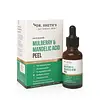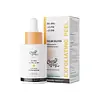What's inside
What's inside
 Key Ingredients
Key Ingredients

 Benefits
Benefits

 Concerns
Concerns

 Ingredients Side-by-side
Ingredients Side-by-side

Water
Skin ConditioningMandelic Acid
AntimicrobialXylitylglucoside
HumectantAnhydroxylitol
HumectantXylitol
HumectantGlycerin
HumectantPolyacrylate Crosspolymer-6
Emulsion StabilisingNiacinamide
SmoothingSodium Hydroxide
BufferingCarica Papaya Fruit Extract
Skin ConditioningMorus Alba Extract
AstringentHyaluronic Acid
HumectantChamomilla Vulgaris Extract
Skin ProtectingCalendula Officinalis Extract
Skin ConditioningAloe Barbadensis Leaf Extract
EmollientPhenoxyethanol
PreservativeAcacia Senegal Gum
MaskingXanthan Gum
EmulsifyingDisodium EDTA
Allantoin
Skin ConditioningWater, Mandelic Acid, Xylitylglucoside, Anhydroxylitol, Xylitol, Glycerin, Polyacrylate Crosspolymer-6, Niacinamide, Sodium Hydroxide, Carica Papaya Fruit Extract, Morus Alba Extract, Hyaluronic Acid, Chamomilla Vulgaris Extract, Calendula Officinalis Extract, Aloe Barbadensis Leaf Extract, Phenoxyethanol, Acacia Senegal Gum, Xanthan Gum, Disodium EDTA, Allantoin
Water
Skin ConditioningGlycolic Acid
BufferingLactic Acid
BufferingMandelic Acid
AntimicrobialPropylene Glycol
HumectantLactobionic Acid
BufferingSodium Hydroxide
BufferingPropanediol
SolventSodium Salicylate
PreservativePolyquaternium-39
Phenoxyethanol
PreservativeHibiscus Sabdariffa Flower Extract
Skin ConditioningAllantoin
Skin ConditioningCeramide Ag
HumectantOryza Sativa Cera
Skin ConditioningAloe Barbadensis Leaf Extract
EmollientXanthan Gum
EmulsifyingPhenethyl Alcohol
MaskingSodium Hyaluronate
HumectantButeth-3
SolventDisodium EDTA
Sodium Benzotriazolyl Butylphenol Sulfonate
UV AbsorberChamomilla Recutita Flower Extract
MaskingTributyl Citrate
SolventPhospholipids
Skin ConditioningSphingolipids
EmollientMaltodextrin
AbsorbentWater, Glycolic Acid, Lactic Acid, Mandelic Acid, Propylene Glycol, Lactobionic Acid, Sodium Hydroxide, Propanediol, Sodium Salicylate, Polyquaternium-39, Phenoxyethanol, Hibiscus Sabdariffa Flower Extract, Allantoin, Ceramide Ag, Oryza Sativa Cera, Aloe Barbadensis Leaf Extract, Xanthan Gum, Phenethyl Alcohol, Sodium Hyaluronate, Buteth-3, Disodium EDTA, Sodium Benzotriazolyl Butylphenol Sulfonate, Chamomilla Recutita Flower Extract, Tributyl Citrate, Phospholipids, Sphingolipids, Maltodextrin
Ingredients Explained
These ingredients are found in both products.
Ingredients higher up in an ingredient list are typically present in a larger amount.
Allantoin is a soothing ingredient known for its protective and moisturizingg properties. Because of this, it is often added to products with strong active ingredients.
Studies show higher concentrations of this ingredient can promote wound healing.
Though it can be derived from the comfrey plant, allantoin is produced synthetically for cosmetic products to ensure purity.
Learn more about AllantoinAloe Barbadensis Leaf Extract is an extract of the leaves of the aloe, Aloe barbadensis, Liliaceae.
Aloe is one of the most well-known natural soothing ingredients, and for good reason. It’s full of water and has a cooling, calming effect on the skin, especially when it’s sunburned, itchy, or irritated. Aloe also helps your skin stay hydrated and smooth by mimicking what healthy skin naturally produces. On top of that, it contains vitamins and nutrients that support skin recovery.
It doesn’t protect you from the sun, but it can help your skin bounce back after too much time in it.
Let’s get into the details:
Aloe contains antioxidant Vitamins A, C, and E, which help fight off free radicals (unstable molecules from things like pollution that can damage your skin).
It’s also rich in polysaccharides, which are natural sugars that help hydrate the skin by acting like the skin’s own moisturizing agents. These, along with other sugars like monosaccharides, help form a protective barrier that locks in moisture.
Aloe works as both a humectant and an emollient. That means it draws water into the skin (humectant) and helps trap it there (emollient), making it an effective natural moisturizer.
You’ll also find a mix of other skin-supporting ingredients in aloe, including folic acid, choline, calcium, amino acids, fatty acids, and even Vitamin B12.
Out of the 420+ species of aloe, Aloe barbadensis is the most widely used in skincare products thanks to its gentle yet effective properties.
There are over 420 species of aloe but Aloe Barbadensis is the most commonly used for topical products.
Learn more about Aloe Barbadensis Leaf ExtractDisodium EDTA plays a role in making products more stable by aiding other preservatives.
It is a chelating agent, meaning it neutralizes metal ions that may be found in a product.
Disodium EDTA is a salt of edetic acid and is found to be safe in cosmetic ingredients.
Learn more about Disodium EDTAMandelic Acid is an alpha hydroxy acid (AHA).
Like other AHAs, it helps exfoliate the surface of the skin by breaking down the bonds that hold dead skin cells together. This helps reveal smoother and brighter skin underneath.
Mandelic acid helps with:
Due to it having a larger molecular size than glycolic acid, mandelic acid is able to penetrate the skin more slowly and evenly. This makes it gentler and less irritating, making it a great option for sensitive or beginner skin.
Despite being milder, mandelic acid is still an effective exfoliant that improves skin texture and tone over time.
What makes mandelic acid stand out from other AHAs? It has antibacterial and antioxidant properties.
These traits make it a great option for acne-prone or problem skin by reducing active breakouts and fading post-acne marks. Studies show that mandelic acid (especially when combined with salicylic acid) can significantly reduce pimples and hyperpigmentation while causing fewer side effects than stronger acids.
Mandelic acid is effective in concentrations of 5% and up with an ideal pH range of 3-4 for at-home use.
Like other AHAs, it’s important to wear sunscreen daily to protect your newly exfoliated skin.
However, unlike glycolic acid, mandelic acid is light-sensitive. Be sure your mandelic acid is packaged in opaque containers to ensure it stays stable and effective.
In short, mandelic acid is a gentle yet powerful AHA that exfoliates, brightens, and helps clarify skin while keeping irritation low. Its antibacterial action makes it especially beneficial for those with acne-prone, sensitive, or uneven skin, offering smoother, clearer, and more even-toned results over time.
Read more about some other popular AHA's here:
Learn more about Mandelic AcidPhenoxyethanol is a preservative that has germicide, antimicrobial, and aromatic properties. Studies show that phenoxyethanol can prevent microbial growth. By itself, it has a scent that is similar to that of a rose.
It's often used in formulations along with Caprylyl Glycol to preserve the shelf life of products.
Sodium Hydroxide is also known as lye or caustic soda. It is used to adjust the pH of products; many ingredients require a specific pH to be effective.
In small amounts, sodium hydroxide is considered safe to use. However, large amounts may cause chemical burns due to its high alkaline.
Your skin has a natural pH and acid mantle. This acid mantle helps prevent harmful bacteria from breaking through. The acid mantle also helps keep your skin hydrated.
"Alkaline" refers to a high pH level. A low pH level would be considered acidic.
Learn more about Sodium HydroxideWater. It's the most common cosmetic ingredient of all. You'll usually see it at the top of ingredient lists, meaning that it makes up the largest part of the product.
So why is it so popular? Water most often acts as a solvent - this means that it helps dissolve other ingredients into the formulation.
You'll also recognize water as that liquid we all need to stay alive. If you see this, drink a glass of water. Stay hydrated!
Learn more about WaterXanthan gum is used as a stabilizer and thickener within cosmetic products. It helps give products a sticky, thick feeling - preventing them from being too runny.
On the technical side of things, xanthan gum is a polysaccharide - a combination consisting of multiple sugar molecules bonded together.
Xanthan gum is a pretty common and great ingredient. It is a natural, non-toxic, non-irritating ingredient that is also commonly used in food products.
Learn more about Xanthan Gum